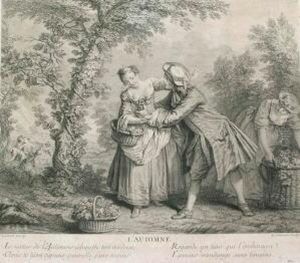Nicolas Larmessin Iv Paintings
Nicolas Larmessin IV was a French engraver, printmaker, and illustrator, born in 1684 into a family with a strong artistic tradition. The Larmessin family, particularly known for their work in engraving, had several members who gained recognition for their contributions to the arts during the 17th and 18th centuries. Nicolas IV was the son of Nicolas III, and he was part of the fourth generation of Larmessin artists, hence the designation 'IV' after his name.
Nicolas Larmessin IV worked primarily in Paris, where he developed his skills as an engraver. His engravings were often elaborate and detailed, reflecting the tastes and interests of the Rococo period, which was characterized by ornate and asymmetrical designs with an emphasis on fluid curves, gilding, pastel colors, and light-hearted themes. He produced a wide range of works, including portraits, decorative prints, and illustrations for books.
Throughout his career, Larmessin IV collaborated with various publishers and authors, contributing engravings to illustrate literary works, historical texts, and scientific publications. His illustrations often served to make complex ideas more accessible to a broader audience, a common practice in the age of Enlightenment when there was a push to disseminate knowledge more widely.
Nicolas Larmessin IV's work is less well-known today than that of some of his contemporaries, but he is still recognized for his contributions to the art of engraving and printmaking. He continued the Larmessin legacy in the arts until his death in 1755. His works can be found in various collections and museums, offering insight into the visual culture of his time and the role of engravers in the dissemination of ideas and knowledge during the Enlightenment.
![[allegories Of Labour]: Seven Plates](https://www.niceartgallery.com/imgs/749428/s/nicolas-larmessin-iv-allegories-of-labour-seven-plates-f63c54d1.jpg)
